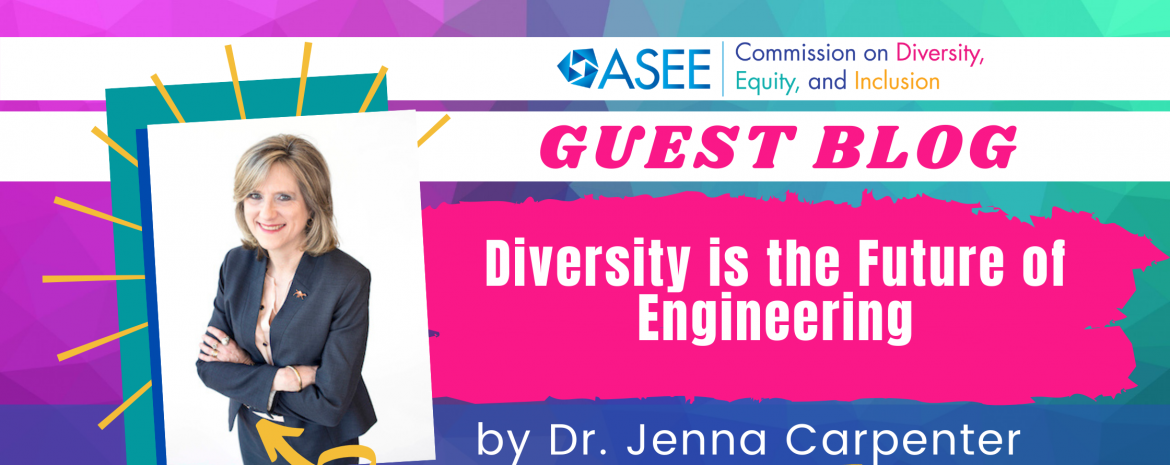Diversity is the Future of Engineering
By Dr. Jenna Carpenter
The Problem
We have collectively worked in the US for the last four decades to attract, educate, and graduate a more diverse cohort of engineers in the US, with a historic focus on attracting more women and students of color. Unfortunately, progress overall has been slow, limited, and sporadic, often visible only in a few subdisciplines or at only a few institutions, and often not translating to the workplace (1, 2,3,4). Moreover, computing as a whole has actually gone backwards over the last forty years, with a noticeable decline, for example, in the number of women it attracts (5). In many engineering, engineering technology and computer science disciplines (which I will refer to here as E/ET/CS), we are still shockingly at or near single digit percentages of historically under-served groups who graduate from these programs.
Why has progress been so slow?
One has to ask, in disciplines that pride themselves on solving problems, why have we not been able to crack this one? What are the major factors that underlie these persistent challenges? Why is it critical that we address these issues now? What can we do to change this? Progress has been slow because the challenges are largely culturally based. You have likely heard the adage “culture eats strategy for breakfast”. As individual disciplines and institutions, it is difficult for us to enact strategic approaches at the local or discipline level that effectively address societal-wide cultural issues.
What are the major cultural factors that underlie these challenges?
The primary factors are implicit bias, stereotypes, and, sadly, still overt bias. Recall that implicit bias is bias that we all have (which comes from our culture) but of which we are largely unaware. It impacts our attitudes, decisions, and actions toward a specific group, say women in E/ET/CS. Collectively, these three – implicit bias, stereotypes, and overt bias – send a continual stream of both subtle and overt messages – through tv and movies, images, social media, toy manufacturers, family, friends, teachers, peers, society at large – that E/ET/CS are only for certain groups, that some groups are not “cut out” to succeed in these fields, not interested in these fields, biologically not wired to major in these fields, etc. (the list of excuses is long).
What problems do these factors cause?
Bias and stereotypes also fuel an ongoing litany of microaggressions, microinsults, and microinvalidations that collectively drive people away from E/ET/CS majors and careers. They include things like verbal, behavioral, and environmental messages and actions that slight, insult, or target an individual or group. They can be derogatory, demeaning, prejudiced, harassing, even abusive and hostile. While most of these “micros” are small when considered individually, the collective impact is catastrophic. Think of it as death by a thousand cuts. They discourage, deny, deter, and eliminate those at whom they are targeted from pursuing or remaining in an E/ET/CS or STEM course, major, or career.
But experts don’t experience this, do they?
As a member of a historically underrepresented group in STEM myself, I can guarantee that I still experience implicit bias and microinsults. This is true even though I am an engineering dean, a tenured full professor of engineering, have held multiple national leadership roles in STEM, have won multiple national awards in STEM, and am in my thirty-second year as a faculty member. So, no, these negative experiences don’t ever stop or go away. They also don’t ever cease to wound, degrade, and demean.

Our Competitive Culture
In addition, for most of our history, the culture in E/ET/CS undergraduate and graduate programs has been very competitive, with a weed-out approach to driving away as many students (and faculty) as possible, as quickly as possible (6). This philosophy is based on flawed notions of who is and is not smart enough to make it through an E/ET/CS program or be a tenured E/ET/CS faculty member or administrator. This competitive culture shapes what we collectively value in our students, faculty, researchers, and administrators. So, for example, we often elevate and desire to emulate expressions of power, dominance, exceptionalism, and individual accomplishment. The competitive culture shapes our behavior and how we treat and interact with others. Criticisms, verbal takedowns, unrealistic standards, competing against your fellow students or faculty to “win” – these are all seen as acceptable behavior. Our competitive culture doesn’t value creating a wide door for a diverse cohort of people to enter and then providing a supportive and collaborative environment that works to help everyone (students and faculty) thrive and excel, while bringing and valuing their individual strengths and expertise to the table. This competitive culture also undermines development of team-based, collaborative skill sets that include working with a diverse array of partners. And yet these are skill sets not only valued by the industries that employ our graduates, but expected of them when they arrive in industry.
Systemic Racism
Another issue of cultural bias is systemic racism. Collectively, we in higher education have long operated under the biased assumption that BIPOC students aren’t prepared for or don’t succeed in E/ET/CS fields due to individual differences in preparation or opportunity. Consequently, many programs focus on providing leveling opportunities for these students. While such programs are still needed, after the last two years it is clear that this narrative of individual difference is wrong. Data shows that systemic racism is alive and well in every segment of society and that such impedes qualified and talented BIPOC students, from birth onward (and even before). If we as a nation don’t acknowledge and address this, we aren’t likely to see any positive changes in the influx of BIPOC students into E/ET/CS majors and careers.
Why is it critical that we act now?
First, it is the right thing to do. It is unacceptable to waste the vast and diverse array of E/ET/CS talent that exists in our country. Research has shown that diversity is key to innovation and complex problem-solving. Our nation and our world have no shortage of massive, complex problems to solve that require a significant amount of E/ET/CS expertise. Solving these problems will require every bit of talent that we as a nation have, most importantly the many diverse viewpoints, skills, and innovation that the broad and diverse swath of human E/ET/CS talent in our nation (provided we cultivate and develop it) possesses.
Second, look at the demographic data for college-aged students for the next eighteen years. Even before the pandemic, we were coping with falling birth rates. The number of high school seniors is declining (with a small bump in the mid 2020’s). Women now outnumber men in college almost 2-1. Minority students now make up the majority of kindergarten students. And none of that factors in the declines in college-going rates, particularly for students from low socio-economic backgrounds and for men, that we have seen the last two years due to the pandemic. If we don’t figure out how to attract a much more diverse cohort of students to E/ET/CS, we have little hope as a country of educating the talent that we need to remain an innovative, economically competitive, secure nation, and to maintain our standard of living. Let the consequences of that sink in for a moment.
How do we turn the tide?
There have been times in our nation’s history when we have dropped our stereotypes and biases because we had to do so. Think of World War II and the vast number of women who went to work in manufacturing, mathematics, and computing. Our backs were against the wall and we had no choice but to toss our artificial rules aside. Sadly, once the emergency created by the war was over, our nation (and others) largely went back to its pre-war stereotypes, dropping the large volume of talented and trained women overnight. Think about the space race, when NASA relaxed the rules about segregation to allow black women to work in STEM jobs. The moral of this story is that it’s our culture and we can change it on a dime if we want to do so. That means that we are all key to solving this problem.
We must change our outdated cultural norms. We must all be aware of our implicit and overt biases, change our behavior/attitudes/actions and eliminate inaccurate stereotypes about who can and should do E/ET/CS. We must get accurate messages out there and start encouraging all students beginning at the preschool level to positively and enthusiastically engage with STEM. We need role models and opportunities for every student to get the education they need to pursue E/ET/CS. We need to change E/ET/CS faculty attitudes, curricula, and culture to weed students into engineering, instead of weeding them out, without reducing the quality of the education we provide (these are not mutually exclusive activities). We need a culture that values the rich diversity students bring and that provides that support in a non-competitive culture to help every student succeed. We need curricula that focus on 21st century skills and use engineering education research to provide a 21st century E/ET/CS education that will prepare graduates for today’s world, not the world of the 20th century.
We as E/ET/CS disciplines have to lead this charge. We have to get the word out that this is urgent to us as a nation. That it is the right thing to do (urgency aside). We have to make this a priority. We can do all of these things. We just have to decide that it’s important enough to do so now.
References
- National Science Foundation/National Science Board. The State of US Science and Engineering 2020, Science and Engineering Indicators, https://ncses.nsf.gov/pubs/nsb20201/u-s-s-e-workforce#women-and-underrepresented-minorities, accessed November 30, 2021.
- National Center for Education Statistics, Number and percentage distribution of science, technology, engineering, and mathematics (STEM) degrees/certificates conferred by postsecondary institutions, by race/ethnicity, level of degree/certificate, and sex of student: 2008-09 through 2017-18, US Department of Education, https://nces.ed.gov/programs/digest/d19/tables/dt19_318.45.asp, accessed November 30, 2021.
- National Center for Science and Engineering Statistics, S&E Degrees, By Race/Ethnicity of Recipients, https://www.nsf.gov/statistics/degreerecipients/, National Science Foundation, accessed November 30, 2021.
- National Science Foundation/ National Science Board, Science and Engineering Labor Force, Women & Minorities in the S&E Workforce, https://www.nsf.gov/statistics/2018/nsb20181/report/sections/science-and-engineering-labor-force/women-and-minorities-in-the-s-e-workforce, accessed December 1, 2021.
- National Center for Education Statistics, Degrees in computer and information sciences conferred by degree-granting institutions, by level of degree and sex of student: 1970-71 through 2017-18, US Department of Education, https://nces.ed.gov/programs/digest/d19/tables/dt19_325.35.asp, accessed November 30, 2021.
- C. Pritlove, C. Juando-Prats, K. Ala-Ieppilampi and J.A. Parsons. The good, the bad, and the ugly of implicit bias, The Lancet. 399 (2019), no. 10171, 502-4, DOI: 10.1016/S0140-6736(18)32267-0.
About the Author

Dr. Jenna P. Carpenter, Founding Dean and Professor of Engineering at Campbell University
Jenna Carpenter
Dr. Jenna P. Carpenter is Founding Dean and Professor of Engineering at Campbell University. With a hands-on, project-based approach all four years, Campbell School of Engineering focuses on design and utilizes unique classlabs to seamlessly integrate lecture and lab. The program also emphasizes teaming, communication skills, student internships, professional engineering licensure, professional development training and service learning. The School has earned a Bronze Award from the ASEE Diversity Recognition Program and is a KEEN Partner Institution.
Do you want to become a guest blogger?
CDEI Guest Blog highlight future events, describe best practices, or share calls to action by CDEI members. We invite you to propose posts that share brief research highlights, reports of impactful initiatives, critical thought pieces, and resources you find useful. We especially encourage emerging scholars to share their work. If you are interested in sharing a blog or resource post, you may submit your proposal here. All posts are screened and edited.

